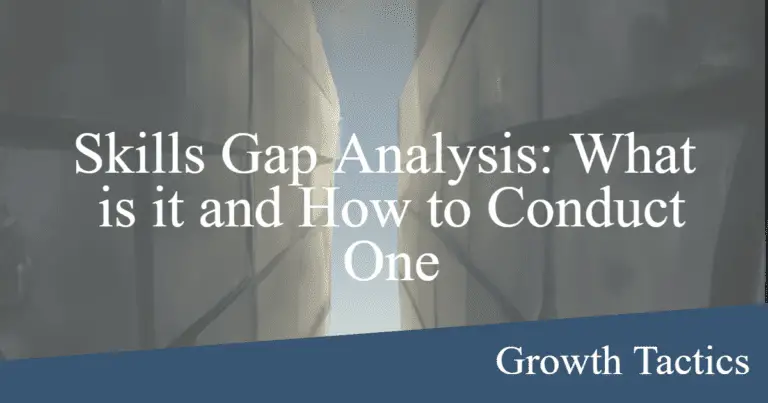Are you struggling to keep up with the constantly changing market demands? Are you finding it challenging to hire employees who have the required skills to meet your business goals?
If you answered yes, then you’re not alone. Many organizations are facing the same dilemma. Here’s the good news: a skills gap analysis can help identify the gaps in your employees’ knowledge and skills.
This analysis will also provide you with a roadmap to develop and implement training programs to close those gaps. So, let’s dive into the world of skills gap analysis and learn how to conduct one.
Jump To Section
Why Is a Skills Gap Analysis Useful?
A skills gap analysis is a useful tool for organizations to identify the skills that an individual employee needs but doesn’t necessarily have yet to carry out their job or perform specific tasks effectively. It can also help organizations determine if their employees have the skills to work on an upcoming project or if they need to hire externally.
A successful skills gap analysis is a vital strategic workforce planning tool that can bring many benefits. It can help an organization see who lacks specific skills and who does not have any gaps, as well as identify the skills needed to meet the organization’s mission statement, growth goals, or brand values.
When Should a Skills Gap Analysis Be Conducted
You should conduct a skills gap analysis whenever you develop or change your business strategy, to ensure that your employees have the necessary skills to make it happen.
This should encompass both soft skills and technical skills. Other times you might identify skills gaps include when you are looking to optimize your long-term recruitment strategy, increase productivity, or get ahead of your competition.
Skills Gap vs Performance Gap
A skills gap is the difference between the skills that employees have and the skills that employers need. It is a measure of the gap between the current skills of an employee and the skills required to perform a particular job. It can be caused by a lack of training, a lack of experience, or a lack of knowledge.
A performance gap is the difference between the performance of an employee and the performance expected of them. It can be caused by a lack of motivation, a lack of resources, or a lack of knowledge.
The two concepts are related but distinct. A skills gap analysis is a tool for identifying the various abilities and skills employees need to match specific job requirements.
A performance gap analysis looks for the reasons why an organization is not achieving certain business goals and considers where the organization is, where it wants to be, and what is preventing it from reaching its goals.
How To Perform a Skills Gap Analysis

Step 1 Identify skills needed for success:
When it comes to identifying the skills that are needed in a company, there are several steps that can be taken.
First, it is important to analyze the company’s mission, goals, and values to identify the skills that are necessary for the organization to achieve its objectives. For example, if the company is looking to increase its customer service offerings, it may need employees with strong communication and customer service skills.
Step 2 Identify which skills are already in the company:
Identify existing skills in the company and query which skills employees already possess. This can be done by conducting interviews, surveys, and assessments to determine the current skills of their employees. Additionally, employers can look at job descriptions and performance reviews to identify the skills that employees have acquired from their work experience.
Step 3 Bridge the gap:
Bridging the gap between needed skills and skills already in the company can be done in a variety of ways. One way is to focus on reskilling initiatives. This can involve acquiring talent, but it is important to note that this approach has a limited impact and can be expensive.
An alternative is to focus on training and development initiatives, such as instructor-led, self-study, or a combination of both. This allows employees to gain the skills they need to fill the gap without having to hire new staff. Additionally, employers can use a skills gap analysis to identify the skills needed and the skills already possessed by employees. This can help to identify the skills gap and then analyze it to determine the best way to bridge the gap.
Another way to bridge the gap is to use a combination of hiring and training. This allows employers to bring in new talent while also providing training to existing employees to ensure they have the necessary skills. Additionally, employers can use performance management tools to identify skill gaps and then provide targeted training to close those gaps.
Finally, employers can use technology to bridge the gap between needed skills and skills already in the company. This can include using artificial intelligence to identify skills gaps and then providing targeted training to close those gaps. Additionally, employers can use virtual reality and augmented reality to provide immersive training experiences to employees.
Challenges of Conducting a Skills Gap Analysis and How to Overcome Them
Conducting a skills gap analysis is a critical task for any organization aiming to align its workforce with its strategic goals. However, this process is not without its challenges. Below are some common obstacles and how you can overcome them:
1. Identifying the Required Skills
Challenge:
Determining which skills are necessary for achieving business objectives can be daunting. This involves understanding both technical and soft skills needed across various roles within your organization.
Solution:
Begin by evaluating the company’s mission, goals, and values. Engage with key stakeholders to gain insights into the strategic direction of the company and the skills required. Tools like job analysis and competency frameworks can help in systematically identifying the necessary skills for each role.
2. Assessing Current Skill Levels
Challenge:
It can be challenging to get an accurate picture of the skills that employees currently possess. This step is crucial for understanding the gap between current capabilities and required skills.
Solution:
Use a combination of qualitative and quantitative assessment methods such as surveys, interviews, performance reviews, and skill assessments. Online tools like iMocha and MuchSkills offer robust platforms for evaluating current skill levels with pre-built assessments and customizable evaluation criteria.
3. Bridging the Skill Gap
Challenge:
Once the gaps are identified, finding the most effective way to bridge them is not straightforward. The options might include hiring new talent, reskilling existing employees, or a combination of both.
Solution:
Develop a blended strategy that incorporates both hiring and training. Invest in training and development programs tailored to the needs identified during the skills gap analysis. Leveraging technologies such as AI for targeted training and virtual/augmented reality for immersive learning experiences can also be highly effective. Additionally, utilizing performance management tools can help in continuously monitoring and addressing skill gaps as they evolve.
4. Resource Constraints
Challenge:
Lack of resources, both in terms of time and budget, is a common challenge when conducting a skills gap analysis.
Solution:
Prioritize critical areas where the skills gaps have the most significant impact on organizational performance. Use cost-effective solutions like e-learning modules and in-house training sessions. Also, leverage free or low-cost online tools and platforms for initial skills assessments to minimize expenses.
5. Keeping the Analysis Updated
Challenge:
The skills landscape is rapidly changing, making it essential to keep the skills gap analysis updated to stay relevant.
Solution:
Make skills gap analysis a continuous process rather than a one-time event. Regularly review and update the analysis in alignment with changing business goals and market trends. Establish a feedback loop from employees and managers to keep the analysis dynamic and responsive to immediate needs.
By recognizing these challenges and implementing the suggested solutions, organizations can conduct effective skills gap analyses that not only identify current shortcomings but also provide a strategic roadmap for workforce development.
Skills Gap Analysis Online Tools
iMocha is a skills intelligence and assessment platform that enables talent teams to make smarter talent decisions. It has a library of over 2,500 skill tests, and businesses can use it to create customized assessments based on learning paths. It also has 500 IT skills, 20 coding languages, 50 aptitude skills, and more. iMocha is used by more than 300 organizations in 70+ countries to acquire job-fit talent faster and measure the ROI from their talent development initiatives.
MuchSkills offers an out-of-the-box setup with over 20,000 skills to choose from. This tool allows team members to map their skills in an efficient and engaging way. It is an excellent choice for conducting a skills gap analysis online.
Digits is an AI-based platform that offers an advanced skill gap analysis tool. The tool provides an automated process for identifying and tracking skills gaps across teams and departments. It offers insights into the skills employees currently have and the skills they need to acquire to improve their performance. It also provides a clear picture of any skill gaps in the organization.
Did you enjoy this article on skills gap analysis? Please share and subscribe below.


